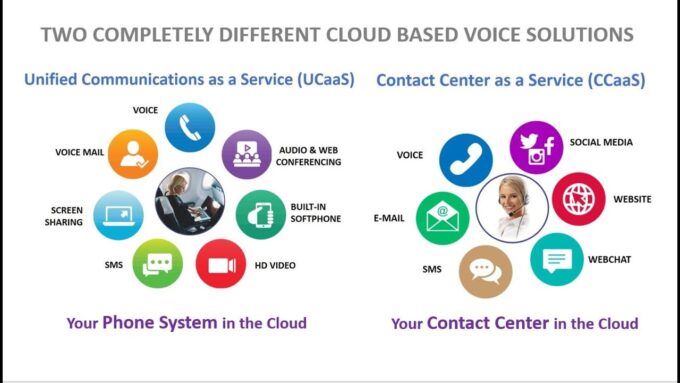Understanding customer support technologies and the nuances between Contact Center as a Service (CCaaS), traditional call centres, and Unified Communications as a Service (UCaaS) is crucial for businesses aiming to optimise their communication strategies.
Differences Between a Call Center and a Contact Center
While the terms “call centre” and “contact centre” are often used interchangeably, they represent distinct customer support technologies. A call center handles voice calls exclusively, while a contact centre manages interactions over various channels, including phone, email, text, and social media. For businesses prioritizing phone interactions, a hosted call center is suitable. However, for those aiming to offer customers multiple communication options, CCaaS is the superior choice.
UCaaS vs. CCaaS Solutions

Similarities Between UCaaS and CCaaS
Both UCaaS and CCaaS share certain similarities:
- Subscription-Based: Both operate on a subscription model, allowing businesses to pay monthly or yearly for cloud communication software.
- Cloud-Based: Neither requires on-premises equipment, functioning entirely over an internet connection.
- Built to Scale: Both offer scalable solutions, providing access to rich features that can be added or adjusted based on changing business needs.
- CRM Integrations: Both UCaaS and CCaaS solutions offer API integrations with popular CRM suites, ensuring seamless connectivity.
Differences Between UCaaS and CCaaS

While both technologies share common traits, there are distinct differences:
- Use Cases: CCaaS is ideal for call centers managing customer communications, while UCaaS caters to internal teams with features like team messaging and video conferencing.
- Customer Interaction Focus: CCaaS is designed for customer service and sales teams dealing with a steady volume of inbound or outbound calls, while UCaaS emphasizes collaboration and multimedia features for internal teams.
Noteworthy CCaaS Benefits
Deliver a Better Omnichannel Customer Experience:
CCaaS platforms excel in delivering a seamless omnichannel experience. Customers today use an average of 13 separate channels to reach a business, and CCaaS ensures that businesses can support customers regardless of their preferred mode of communication—be it phone, email, or social media. The ability to centralize customer interactions provides a unified view, enhancing customer service and loyalty.
AI-Powered CCaaS: The Future of Customer Support

Real-Time Analytics in CCaaS
The Essence of Data-Driven Decision-Making:
Real-time analytics in CCaaS refers to the ability to collect, process, and analyze data instantaneously as customer interactions occur. This capability empowers businesses to gain immediate insights into agent performance, customer sentiment, and operational efficiency, allowing for rapid course corrections and improvements.
Speed and Flexibility
CCaaS stands out in terms of speed and flexibility. Deploying a cloud contact center takes days, not months, allowing businesses to adapt swiftly to changing customer demands. With less hardware dependency, teams can focus on exceeding customer expectations rather than dealing with complex infrastructure issues.
Key Components of Real-Time Analytics in CCaaS
- Live Dashboards: Visual representations of critical metrics provide a real-time snapshot of contact center performance.
- Agent Performance Monitoring: Tracking individual agent KPIs in real-time enables timely feedback and coaching for continuous improvement.
- Customer Sentiment Analysis: Utilizing natural language processing and sentiment analysis tools to gauge customer emotions during interactions.
- Queue Management: Dynamically managing call queues based on real-time demand ensures efficient customer service.
- Adaptive Routing: Routing customer inquiries to the most qualified agents based on real-time data ensures optimal resolution.
Turning Data into Actionable Insights

Real-time analytics enables businesses to turn data into actionable insights in several ways:
- Optimizing Agent Performance: Managers can monitor agent activity in real time, identifying areas for improvement and offering timely coaching and support.
- Proactive Issue Resolution: Identifying emerging issues or trends in real time allows businesses to take proactive steps to address them before they escalate.
- Enhancing Customer Experiences: By monitoring customer sentiment in real time, businesses can respond swiftly to negative feedback, demonstrating a commitment to resolving issues and ensuring a positive customer experience.
- Dynamic Resource Allocation: Real-time insights allow for dynamic resource allocation based on current demand, ensuring efficient operations.
AI-Powered CCaaS: The Future of Customer Support
AI-powered CCaaS is reshaping the landscape of customer support by introducing advanced capabilities that enhance efficiency and customer satisfaction. Some key aspects of AI in CCaaS include:
- Omnichannel Support: AI enables seamless communication across various channels, providing a consistent experience for customers.
- Predictive Analytics: AI algorithms analyze historical data to predict future customer behavior, helping businesses anticipate needs and preferences.
- Chatbots and Virtual Assistants: AI-driven chatbots and virtual assistants handle routine queries, freeing up human agents to focus on more complex issues.
- Speech Analytics: AI-powered speech analytics analyze customer-agent conversations for sentiment and intent, providing valuable insights for improvement.
- Predictive Routing: AI algorithms predict the best-suited agent for a particular inquiry, optimizing call routing for better resolution times.
Choosing the Right CCaaS Solution

Selecting the right CCaaS solution requires careful consideration of various factors:
- Full Omnichannel Support: Ensure the platform provides comprehensive omnichannel support, including universal routing, automatic call distribution, and interactive voice response.
- Scalability and Handling Fluctuations: Evaluate whether the solution can handle fluctuations in customer volume and offers scalability to adapt to business growth.
- Security Measures: Prioritize security by checking for encryption, access controls, and disaster recovery measures to protect customer data and privacy.
- Self-Service and Assisted-Service Capabilities: Confirm that the CCaaS platform caters to both self-service and assisted-service interactions and transactions.
- Proactive Communication Features: Assess the capability for proactive communication, including outbound dialing, SMS, and email notifications.
- Integration with Current and Future Software Systems: Ensure compatibility with existing and future software systems through APIs and seamless integration capabilities.
- Ease of Data Access: Verify whether customer data can be easily accessed through web-based applications or CRM functionality.
- Comprehensive Reporting and Analytics: Look for robust reporting and analytics tools for tracking key metrics such as wait times, resolution times, and customer feedback.
Choosing the Right CCaaS Partner
Choosing the right CCaaS partner is equally important. Consider factors like vendor reputation, scalability, security, integration capabilities, training and support, cost structure, innovation, and user-friendly interface when selecting a partner.










